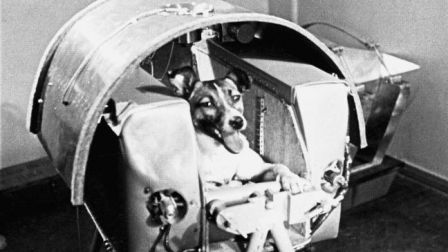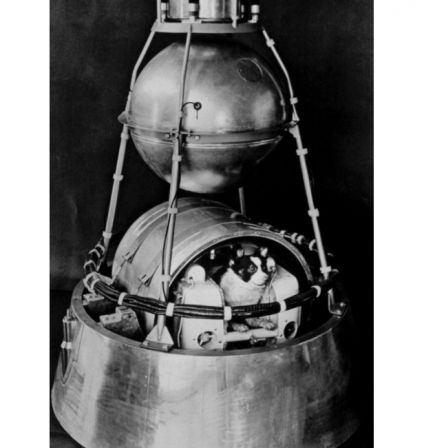November 3, 1957: Laika the space dog becomes first living creature in orbit
Par Joel pumi le mardi, novembre 3 2015, 12:37 - Lien permanent
A stray dog called Laika became the first living thing in space when she orbited the earth in the Soviet Sputnik 2 satellite - but lived for only minutes after launch.
A stray dog called Laika became the first living creature launched into orbit – and tragically died – on this day in 1957.
Launched at the height of the Russian-American Space Race, Sputnik 2 was a rushed Soviet space mission which came less than a month after the successful launch of Sputnik 1, the first artificial Earth satellite.
Soviet leader Nikita Krushchev wanted his engineers to follow Sputnik 1 with a "space spectacular" – and it was decided that this would be the launch of the first living animal into orbit.
That living animal turned out to be Laika – a three-year-old stray mongrel who was found wandering the streets of Moscow. Soviet scientists believed such dogs would be used to extreme conditions, having suffered severe cold and hunger while living as a stray.
Laika was trained along with two other dogs – Albina and Mushka – and was reportedly chosen to be the ‘flight dog’ out of the trio because of her small size and calm demeanour. “Laika was quiet and charming,” one of the Soviet scientists would later write.
But it was a guaranteed suicide mission: Laika’s death was expected from the outset, as Sputnik 2 was never designed to be retrievable.

Laika was placed in the capsule of Sputnik 2 – where she only had enough room to sit or lie down – on October 31, three days before the launch. One of the technicians involved later said that before closing the hatch they “kissed her nose and wished her bon voyage, knowing that she would not survive the flight”.
Sputnik 2 reached orbit and the launch was reported as a success, with the Soviets even claiming that Laika might be parachuted safely back to Earth.
But some of the craft’s thermal insulation tore loose, raising the cabin temperature to 40°C. Medical sensors on Laika showed that during launch, her pulse rate was three times higher than its resting level – and it took three times longer to settle back down than it had done during ground tests.
Sacrificed in order to test the safety of space travel for humans, it wasn’t until 2002 that the truth emerged about how Laika died – and how long she had survived.
For years, the Soviet Union insisted that Laika had died painlessly after several days in orbit – and it had indeed been the plan to euthanise her with poisoned dog food after a week of testing.
But in October 2002, Dimitri Malashenkov, one of the scientists involved in Sputnik 2, told the World Space Congress in Houston that five to seven hours into the flight, Laika’s monitors were showing no signs of life. By the spacecraft’s fourth orbit, it was clear that she had died from overheating and stress. "It turned out that it was practically impossible to create a reliable temperature control system in such limited time constraints," he said.
The two men who trained Laika were Oleg Gazenko and Vladimir Yazdovsky, life-scientists who led the Soviet’s program of sending animals into space. Yazdovsky later revealed that he took Laika home to play with his children the day before launch, explaining: “I wanted to do something nice for her: She had so little time left to live.” And in 1998, following the collapse of the Soviet regime, Gazenko publicly expressed regret over Laika’s death.
“Work with animals is a source of suffering to all of us. We treat them like babies who cannot speak,” he said.
“The more time passes, the more I'm sorry about it. We shouldn't have done it ... We did not learn enough from this mission to justify the death of the dog.”

Laika the space dog - Did you know?
- Laika was a mongrel, thought to be part-husky and possibly part-terrier.
- She was originally named Kudryavka (‘Little Curly’) by the Soviet scientists, but was later renamed Laika, which means ‘Barker’.
- The American press gave her various nicknames, including ‘Muttnik’ and ‘Pupnik’.
- The mission sparked a global debate on animal rights and the ethics of animal testing. Groups protested against the Soviet Union’s actions, and demonstrations took place outside Soviet embassies and the United Nations. People were urged to pray for Laika and observe a minute’s silence to think of her.
- Her ‘coffin’ Sputnik 2 continued to orbit the Earth for five months after its launch – and her death – burning up when it re-entered the Earth’s atmosphere on April 4, 1958.
- Laika is memorialised in the form of a statue and plaque at Star City, Russia, the Russian Cosmonaut training facility.
- She has also been commemorated on stamps and in artwork, songs, books and cartoons – and even had a brand of cigarettes named after her.
- During the 1950s and 1960s, the USSR used at least 57 dogs in orbital and sub-orbital space flights. Four other dogs died in Soviet space missions.